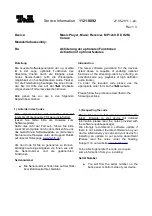
DVD PLAYER MD 40814
9
C
ONNECTIONS
AND
CONNECTION
OPTIONS
The unit can be connected in various ways to other input and output de-
vices:
to a television
to a video recorder
to a receiver, e.g. stereo system
Make sure that all units are switched off before connecting them.
Only connect the units to the mains when the other connections are
complete.
Setting up the unit
Place the unit on a sturdy, level surface. Always make sure that
there is adequate ventilation
no sources of heat affect the unit;
the unit is not in direct sunlight;
you avoid contact with liquids or water
the unit is not placed close to magnetic fields (e.g. televisions or other
loudspeakers).
Some aggressive furniture paints can weaken the unit's rubber feet. If nec-
essary, place the units on a suitable underlay.
The DVD player connections
Your recorder has standard video, SCART, S-video and component out-
puts. The S-video cable provides better image quality than the video cinch
cable. In turn the SCART cable provides better image quality than the S-
video cable.
PROGRESSIVE SCAN
If your television has a so-called "Progressive Scan" function the best image
quality is achieved via the component outputs. An increased image fre-
quency is output using the Progressive Scan procedure. This reduces flick-
ering images to a minimum and displays movements in a more fluid man-
ner.
It goes without saying that your TV must be able to process this format for
it to be used. The PROGRESSIVE SCAN function does not work with a
SCART or other video connection.
Basic settings for video mode
The basic setting installed at the factory for the video mode (
V-MODE
but-
ton) is
V I D E O
. Depending on the connection type used you may need
to select a different video mode (refer to refer to “Video mode”, P. 14).
After connecting the DVD player and selecting the video channel, if you
can not see an image or see a very poor or heavily colour cast image, select
a different video mode using the
V-MODE
button.








































